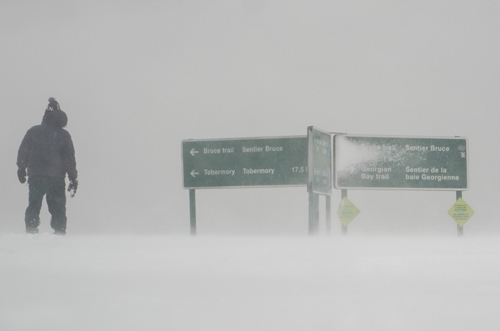
Winter safety
Bruce Peninsula National Park
Winter presents different hazards. You need to plan and prepare for a winter visit to Bruce Peninsula National Park. The trails and roads in the park are not regularly patrolled. Local services are limited in the winter, travel with extra warm clothes, food and water. Winter driving on the Bruce Peninsula can be hazardous, travelling to the park without snow tires is not recommended.
Be careful, stay off the ice especially near water.

Remember:
Emergency response is limited during winter.
Winter conditions can be dangerous - be prepared and cautious.
Drive accordingly.
Winter tires are suggested for road conditions on the Peninsula and within the park. Please slow down and drive with care.
Do not expect your phone to work.
Cell phone reception is not reliable in the park.
Make a trip plan and share it with somebody.
Make sure to tell another person what you are doing, where you are going, and when you intend to be back.
Winter weather and snow depth can change quickly.
It is possible to go from clear skies to white-out snowstorms in a short period. Monitor the weather forecast before and during your trip. Check the forecast for Tobermory here. Road conditions vary widely on the Peninsula, with road closures a possibility during the winter.
Do not approach the edge!
The shoreline can be icy and dangerous, especially at Indian Head Cove and the Grotto. Proper footwear is required to access these locations. Winter hiking boots with proper tread are must at a bare minimum.
Stay off the ice.
The ice over Georgian Bay is thin and will not support weight. The ice will drift from shore without notice and in moments, leaving you stranded. As a rule, no ice is safe ice. Ice on inland lakes are susceptible to insulation from snow and slush which varies ice conditions.
Know your limits.
Winter activity can be strenuous. Walking through deep snow takes a lot of energy.
Give yourself enough time.
Daylight hours are shorter than in summer. Plan hikes and drives accordingly.
Get the right equipment.
Make sure you’re equipped to survive many hours in the cold.
Here is a list of some useful items:
- A warm change of clothing.
- Winter boots or winter footwear
- Flashlight and extra batteries
- Fire-starting kit
- Whistle
- First aid kit
- Emergency blanket
- Pocket-knife
- Park map, compass, GPS, cellular phone, etc.
- Enough food and water
- Rugged winter boots – sneakers or boots without tread on the bottom WILL NOT SUFFICE. (Pro-tip: try ice-cleats or crampons for your boots to help with traction on ice!)
- Snowshoes
Check out the Adventuresmart site for more tips and tools to keep you safe.
- Date modified :